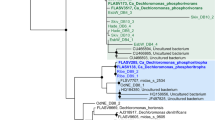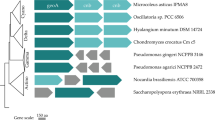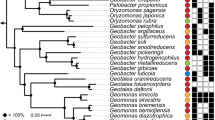Abstract
With the increased use of chemical fertilizers in agriculture, many densely populated countries face environmental problems associated with high ammonia emissions. The process of anaerobic ammonia oxidation (‘anammox’) is one of the most innovative technological advances in the removal of ammonia nitrogen from waste water1,2. This new process combines ammonia and nitrite directly into dinitrogen gas3. Until now, bacteria capable of anaerobically oxidizing ammonia had never been found and were known as “lithotrophs missing from nature”4. Here we report the discovery of this missing lithotroph and its identification as a new, autotrophic member of the order Planctomycetales, one of the major distinct divisions of the Bacteria5. The new planctomycete grows extremely slowly, dividing only once every two weeks. At present, it cannot be cultivated by conventional microbiological techniques. The identification of this bacterium as the one responsible for anaerobic oxidation of ammonia makes an important contribution to the problem of unculturability.
This is a preview of subscription content, access via your institution
Access options
Subscribe to this journal
Receive 51 print issues and online access
$199.00 per year
only $3.90 per issue
Buy this article
- Purchase on Springer Link
- Instant access to full article PDF
Prices may be subject to local taxes which are calculated during checkout



Similar content being viewed by others
References
Jetten, M. S. M., Horn, S. J. & van Loosdrecht, M. C. M. Towards a more sustainable wastewater treatment system. Wat. Sci. Tech. 35, 171–180 (1997).
Strous, M., Van Gerven, E., Ping, Z., Kuenen, J. G. & Jetten, M. S. M. Ammonium removal from concentrated waste streams with the anaerobic ammonium oxidation process. Water Res. 31, 1955–1962 (1997).
Van de Graaf, A. A., de Bruin, P., Robertson, L. A., Jetten, M. S. M. & Kuenen, J. G. Metabolic pathway of anaerobic ammonium oxidation on basis of15N-studies in a fluidized bed reactor. Microbiology 143, 2415–2421 (1997).
Broda, E. Two kinds of lithotrophs missing in nature. Z. Allgem. Mikrobiol. 17, 491–493 (1977).
Schlesner, H. & Stackebrandt, E. Assignment of the genera Planctomyces and Pirella to a new family Planctomycetaceae fam. nov. and description of the order Planctomycetales ord. nov. Syst. Appl. Microbiol. 8, 174–176 (1986).
Fuerst, J. A. & Webb, R. I. Membrane-bounded nucleoid in the eubacterium Gemmata obscuriglobus. Proc. Natl Acad. Sci. USA 88, 8184–8188 (1991).
Lindsay, M. R., Webb, R. I. & Fuerst, J. A. Pirellulosomes: a new type of membrane-bounded cell compartment in planctomycete bacteria of the genus Pirellula. Microbiology 143, 739–748 (1997).
Fuerst, J. A. The planctomycetes: emerging models for microbial ecology, evolution and cell biology. Microbiology 141, 1493–1506 (1995).
Vergin, K. L.et al. Screening of a fosmid library of marine environmental genomic DNA fragments reveals four clones related to members of the order Planctomycetales. Appl. Environ. Microbiol. 64, 3075–3078 (1998).
Neef, A., Amann, R. I., Schlesner, H. & Schleifer, K. H. Monitoring a widespread bacterial group: in situ detection of planctomycetes with 16S rRNA-targeted probes. Microbiology 144, 3257–3266 (1998).
Hugenholtz, P., Goebel, B. M. & Pace, N. R. Impact of culture-independent studies on the emerging phylogenetic view of bacterial diversity. J. Bacteriol. 180, 4765–4774 (1998).
Byers, H. K., Stackebrandt, E., Hayward, C. & Blackall, L. L. Molecular investigation of a microbial mat associated with the Great Artesian Basin. FEMS Microbiol. Ecol. 25, 391–403 (1998).
Zarda, B. et al. Analysis of bacterial community structure in bulk soil by in situ hybridization. Arch. Microbiol. 168, 185–192 (1997).
Liesack, W., König, H., Schlesner, H. & Hirsch, P. Chemical composition of the peptidoglycan-free cell envelopes of budding bacteria of the Pirella/Planctomyces group. Arch. Microbiol. 145, 361–366 (1986).
König, E., Schlesner, H. & Hirsch, P. Cell wall studies on budding bacteria of the Planctomyces/Pasteuria group and on a Prosthecomicrobium sp. Arch. Microbiol. 138, 200–205 (1984).
Strous, M., Heijnen, J. J., Kuenen, J. G. & Jetten, M. S. M. The sequencing batch reactor as a powerful tool for the study of slowly growing anaerobic ammonium oxidising microorganisms. Appl. Microbiol. Biotechnol. 50, 589–596 (1998).
Fuqua, C. & Greenberg, E. Self perception in bacteria: quorum sensing with acylated homoserine lactones. Curr. Opin. Microbiol. 1, 183–189 (1998).
Ludwig, W. et al. Bacterial phylogeny based on comparative sequence analysis. Electrophoresis 19, 554–568 (1998).
Delong, E. F., Franks, D. G. & Alldredge, A. L. Phylogenetic diversity of aggregate-attached versus free-living marine bacterial assemblages. Limnol. Oceanogr. 38, 924–934 (1993).
Fuerst, J. A. et al. Isolation and molecular identification of planctomycete bacteria from postlarvae of the giant tiger prawn Penaeus monodon. Appl. Environ. Microbiol. 63, 254–262 (1997).
Woese, C. R. Bacterial evolution. Microbiol. Rev. 51, 221–271 (1987).
Van de Graaf, A. A., Debruijn, P., Robertson, L. A., Jetten, M. S. M. & Kuenen, J. G. Autotrophic growth of anaerobic ammonium oxidizing microorganisms in a fluidized bed reactor. Microbiology 142, 2187–2196 (1996).
Acknowledgements
We thank A. Raghoebarsing and J. Schalk for technical assistance; M. Wagner (TU Munich, Germany) for instruction on fluorescent in situ hybridization; and the Foundation of Applied Research (STW) for financial support. J.A.F. and R.W. acknowledge the support of the Australian Research Council.
Author information
Authors and Affiliations
Corresponding author
Rights and permissions
About this article
Cite this article
Strous, M., Fuerst, J., Kramer, E. et al. Missing lithotroph identified as new planctomycete. Nature 400, 446–449 (1999). https://doi.org/10.1038/22749
Received:
Accepted:
Issue Date:
DOI: https://doi.org/10.1038/22749
This article is cited by
-
A loading rate switch strategy for stable nitritation in mainstream municipal wastewater
Nature Sustainability (2024)
-
Anammox with alternative electron acceptors: perspectives for nitrogen removal from wastewaters
Biodegradation (2024)
-
Oxygen tolerance and detoxification mechanisms of highly enriched planktonic anaerobic ammonium-oxidizing (anammox) bacteria
ISME Communications (2023)
-
Phylogenetic and metabolic diversity of microbial communities performing anaerobic ammonium and methane oxidations under different nitrogen loadings
ISME Communications (2023)
-
Warming affects herbaceous germination, early survival, and growth by shifting plant-soil microbe interactions in an alpine ecosystem
Plant and Soil (2023)
Comments
By submitting a comment you agree to abide by our Terms and Community Guidelines. If you find something abusive or that does not comply with our terms or guidelines please flag it as inappropriate.



